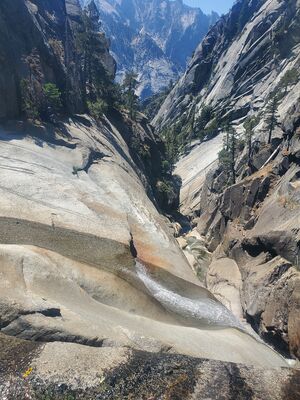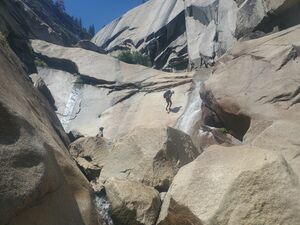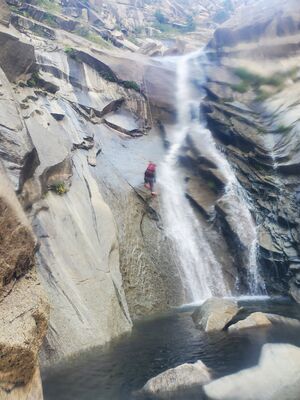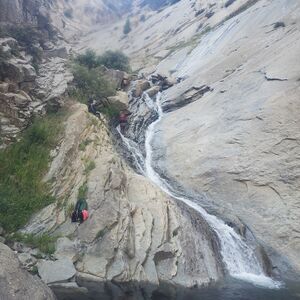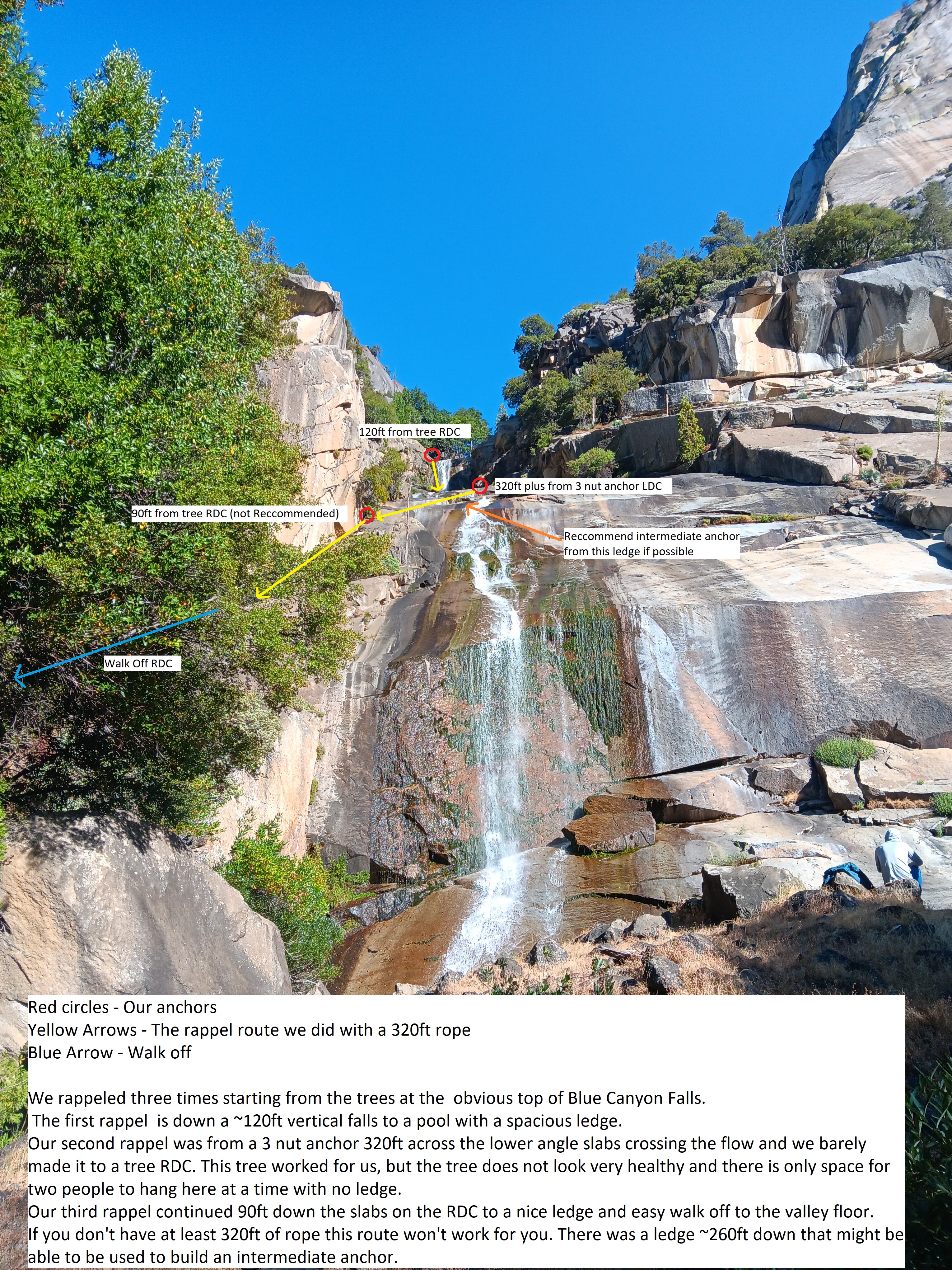Blue Canyon
| Rating: | |||||||||||||||||||||||||||||||
|---|---|---|---|---|---|---|---|---|---|---|---|---|---|---|---|---|---|---|---|---|---|---|---|---|---|---|---|---|---|---|---|
| | Raps:23, max ↨260ft
Red Tape:Permit required Shuttle:None Vehicle:Passenger | ||||||||||||||||||||||||||||||
| Location: | |||||||||||||||||||||||||||||||
| Condition Reports: | 16 Aug 2025
"Aaron Clair, Eric Pelkey, Abbe H, Jake W, Tommy C, Aya O.. Planned to backpack in Friday, due Blue Saturday then set up camp at the base of Crown, |
||||||||||||||||||||||||||||||
| Best season: | Jul to Sep
|
||||||||||||||||||||||||||||||
| Regions: | |||||||||||||||||||||||||||||||
Introduction[edit]
One of the jewels of Tehipite Valley, Blue Canyon drops nearly 3,000 feet of elevation through giant granite walls with enough rappels to easily lose track. Tehipite Valley is waaaay out there and makes for a world class wilderness adventure.
Unless you hate life or would like to hate life, get a group, save up around $400 a person, and call Clyde Pack Outfitters to haul your stuff around to the top and bottom of the canyon. Well worth it.
Approach[edit]
From the Rancheria Trailhead to a campsite above Blue Canyon is approximately 13 miles. The first 6.5 miles took about 3 hours, while the second 6.5 miles took about 5 hours. After the Blue Canyon Trail diverges off from the Crown Valley / Tehipite Valley Trail, there is a ton of deadfall on the Blue Canyon Trail, and the Blue Canyon Trail becomes difficult to find/follow.
Drop in at the obvious spot where the trail to Blue Canyon nears the creek.
Descent[edit]
Start early in the day, it's a long one. The first part of the canyon is likely the best, through deep and polished slots. Further down it gets more of a v-shape with a little bit of rock fall into the canyon. When you notice trees in the middle you're getting close to the end. We used all natural anchors in the canyon, and in the upper section, rappels are all relatively small, nothing more than 100 feet I think.
One big awesome rappel of maybe 120 feet out of the trees takes you to a pool, and as you exit, you'll notice things look very steep ahead. Climbing around a ledge to your gith will get you to a tree to anchor off of down to a big ledge above the 250 foot high Blue Canyon Falls. There is a good tree to anchor off of down there, but if you walk over to it, you might die. The rock is very slippery. Find a way to rappel to that tree, or rather to rappel off of something easier to get to. Trust me, don't walk out to it. The scariest minutes of my life happened watching a friend try it.
Rigging Topo[edit]
This rigging info was collected by the August 2025 team. No bolt or piton anchors were encountered or used. All anchors were webbing, slings, and/or nuts on natural features.
After gearing up, proceed down canyon on slabs and down water slides. The slides will slowly become steeper and longer, until you end up at R1.
R1: anchor LDC on a tree, ten feet above slippery water slide slabs. 30 foot pitch. Could be done as a somewhat fast and treacherous slide.
R2: anchor LDC / center canyon off pinch point. 40 foot pitch down 20 foot waterfall.
R3: anchor RDC off tree; traverse RDC past waterfall roughly 30-60 feet to tree; 70 or 80 foot pitch. (Definitely shorter than 100 feet.)
R4: traverse LDC across somewhat exposed and slippery slab around corner to tree. Recommend belay 20-30 feet across slab traverse. Probably a 120 to 150 foot pitch. (Definitely shorter than 200 feet). Rap next to a beautiful waterfall.
Canyon becomes slottier below this drop.
R5: anchor is two nuts LDC on left wall; proposed alternate anchor is around the three foot diameter log in the middle of the stream. 170 foot pitch from the nuts on the left, or a theoretical 200 foot pitch from the log. Rappel down the steep slab into the narrow slot below. Stay high to and traverse sideways on rappel to stay above the slippery waterslide log embedded in the slot.
Warning! R5 has complications. Read the following carefully.
Warning! For the nut anchor, the nuts are good, but the webbing rigging is not ideal and should be replaced.
Warning! Be careful with pull down: R5 pull down was very hard. Two men were needed to pull the rope down, and then the free end of the rope immediately became entangled in the embedded waterslide log. They were able to climb up the log with great difficulty in low flow to retrieve both 200 foot ropes. In higher flow, climbing back up the log may have been impossible.
It is recommended to attempt to find an intermediate anchor for R5 and break R5 into two pitches. This should make the pull-down easier.
After R5, downclimb a 10 foot waterfall
R6: anchor is RDC off webbing on a chockstone. 50 foot pitch.
Below R6, the narrow slot opens up, and you can see down into Tehipite Valley
R7: Anchor is RDC off webbing on a chock stone. 100ft pitch.
R8: Anchor is center canyon immediately right of water, on a boulder pinch point. Approximately 70 foot pitch down a curved slab.
R9: center canyon around log firmly stemmed above stream. 20 foot nuisance pitch; double strand rappel around polished log; no rap ring or anchor necessary.
R10 and R11: can be rigged as a single 200 foot pitch. Anchor is LDC on pinch point. Mind the severe rub point at the top.
R12: anchor is LDC off a pinch point in the stream. It is a 20-foot pitch.
R13: anchor is LDC. R13 is a 70 foot slippery slab rappel.
R14: anchor is RDC off a pinch point. R14 is a 90 foot splashy slab rappel.
R15: anchor is RDC off webbing on a log. About 50 foot pitch.
R16: anchor is center canyon off webbing in a pinch point. R16 is a 100 foot low angle waterfall slab rappel.
R17: anchor is off a pinch point center canyon. Two tier waterfall rappel. 100 ft pitch.
Below R17, the character of the canyon starts to become more bouldery. Rock hop down canyon for about 15 minutes. If you get cliffed out in house size boulders RDC, look LDC for a walkable scree field.
R18: 10 foot nuisance drop off rock chock center canyon. Possibly R18 may be bypassed with more thorough investigation of the boulder field.
Below R18, rock hop for five more minutes down canyon.
R19: Anchor off tree center canyon. 40 foot pitch rappelling past boulders.
R20: Anchor on a boulder pinch point LDC. 30 foot pitch.
Rock hop down the boulder field for 200 more feet
R21: Anchor off a pinch point RDC. 50 foot pitch into a pool.
Below R21, carefully rock hop down canyon through the 500 foot long zone of recent rockfall. A huge rockfall event has happened here, probably in early 2025, covering up whatever was here before. Exercise caution as these rocks are especially unstable.
R22: Anchor is LDC off a tree. Pitch is 180 feet. Rappel down a medium angle slab, then through a tree canopy, then down a shallow angle waterfall slab.
Continue down canyon for 300 feet. You will pass through some lovely pools and shady glades.
R23 and R24: R23 and R24 are the final drop sequences. These drops are down Blue Canyon Falls.
R23: Anchor is webbing around tree RDC. This is the second to last rappel. Pitch is a steep 120 foot rappel into a pool.
R24: Rap 24 is the final rappel and is this canyon’s “big rappel”.
Warning! R24 has complications. Read the following carefully.
Rap 24 is reported to be 260 feet in the guidebook “Slippery When Wet” and in prior Ropewiki beta. In August 2025, a team rigged a 320 foot rope from the nut anchor LDC. This team was short-roped.
The following describes the rigging used by the August 2025 team. This is contrary to the guidebook. The rappel plan described here (using a 320, 2x 200’s (as pull cord), and a 90+) may not be ideal.
R24 Pitch 1: Excellent nut anchor on the wall LDC, 15 feet before the lip of the drop. Rap 24 is a multi-tier high and low angle slab with a waterfall in the center. Using a 320 foot rope, rappel down, crossing the stream to a tree RDC.
R24 Pitch 2: Sling around tree RDC. Rappel 90 feet down slab to the walk-off RDC. Walk RDC for a few dozen feet, then force your way through vegetation downhill for 50 feet, reaching the base of Blue Canyon Falls and exiting Blue Canyon. Congratulations.
Notes on R24:
A 320 foot rope is also useful for the big rappels in Heaps Canyon in Utah, and Waterholes Canyon and Insomnia Canyon in Arizona.
There are a number of trees RDC. Hypothetically, R24 Pitch 1 can be made shorter than 320 feet if R24 Pitch 2 is made longer than 90 feet.
The pull-down of the 320 went well for the August 2025 team. However, there was no real estate on the tree-anchor to handle that much rope, and untangling+packing the rope was extremely time consuming.
The bottom of Blue Canyon Falls slab is 5th class down-climbable slab on the RDC side at the bottom and potentially also on the LDC side at the bottom. Center canyon, Blue Canyon Falls is a 50 foot vertical drop.
((My notes and memory say the he ~260ft rappel is from the top of the last falls, either from a barely DCL boulder near the bottom of the next to last falls, or from a tree DCL that is unsafe to approach off rope. But the approach the 2025 group described also sounds great! -Rick Ianniello.))
Blue Canyon Miscellaneous Descent/Canyon Beta[edit]
The August 2025 team found only two anchors still remaining from previous teams. For building anchors, the August 2025 team used about 120 feet of webbing, and used 5 nuts, 21 rappel rings, and 1 screwlink. The waterflow on the Aug 2025 descent was approximately 4.5 CFS, which tracked with the waterflow prediction schematic presented in "Slippery When Wet" guidebook.
Below the narrows above R6 and especially below R17, the canyon widens. Plan on doing Blue Canyon in a day, as there aren’t any comfortable camp sites. However, there are some rocky, uneven bivy sites. You won't fall in the water, but you also might not fall asleep. There may be an adequate bivy site above R23, within sight of freedom.
Regarding rope lengths, one 100-120 foot rope, two 180-200 foot ropes, and one 320 foot rope are probably good choices. Many drops are barely too long for an 80 foot rope to be ideal.
Consider bringing a set of nuts to build anchors with.
Blue Canyon has no obvious escape path.
Blue Canyon Approximate Timing[edit]
This timing is based on the August 2025 6-person team.
T+0 hours: finish putting on wetsuits and harnesses and begin the canyon.
T+1 hours: top of R4
T+3.5 hours: top of R9
T+6.5 hours: top of R17
T+9 hours: top of R22
T+11 hours: first team member reaches bottom of R24
T+12.5 hours: R24 pull-down complete and all ropes packed
Exit[edit]
Down Tehipite Valley for 3 miles and then climbing out one hell of a trail. The views are nice, but start early. There's no water until you get up past the top, and it will get hot.
The Tehipite Trail and the Crown Valley Trail are in better condition, as of 2025, than the Blue Canyon Trail. Climbing the “65 Switchbacks” out of the Tehipite Valley (~3000 feet of gain) takes about 2.5 hours. Hiking from the crest of the switchbacks to the Rancheria shortcut TH takes about 7 hours.
Red tape[edit]
You will need a permit to do this canyon. Clyde Pack Outfit will get the permit for you as part of your fee though, which is convenient, because then you don't have to pick it up. Also, you really don't want to carry all of your gear 18 miles out to the canyon, down the canyon, and then out on that heinous trail. You really really don't.

